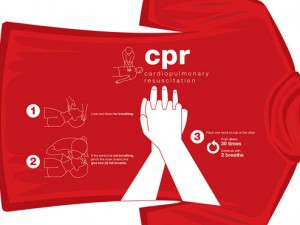 A picture’s not only worth the proverbial thousand words, but can save a life. So can a t-shirt…er, TeachShirt.
A picture’s not only worth the proverbial thousand words, but can save a life. So can a t-shirt…er, TeachShirt.
At the Unniched meeting held on 25 October 2011 in NYC, I spent a few minutes talking with two members of Zemoga‘s brain trust: Sven Larsen, Chief Marketing Office, and the firm’s Principal Design guru, Dan Licht.
We discussed how design is so critical a factor in health, and in life — particularly, in DIY health, where we are all taking on more responsibility for our own health care — clinical, financial, mental, social.
Among Zemoga’s colorful and uber-creative portfolio is its concept, the TeachShirt (say it fast out loud, and you’ll get the intended pun). I will be proud to wear my very cool CPR TeachShirt, shown in the photo.
The simple elegance of the shirt is that, instead of posting CPR instructions on a billboard or website, people wearing the shirt socialize the health information as they move about in their communities. Thus, important health messages get into peoples’ mindsets, and health literacy organically spreads.
There are TeachShirts for preventing AIDS, promoting kids’ health, water and sanitation, dealing with earthquakes, and other public health issues.
The Teach Shirt was inspired by Zemoga’s work with PSFK on the brilliantly-executed UNICEF report on the Future of Health — a publication I wish I had worked on myself!
Health Populi’s Hot Points: Health literacy is one of the key barriers preventing the widespread embrace of participatory health and the larger issue of health engagement and activation. This is a challenge facing every nation on the planet, whether economically developed or developing.
Health literacy spans a broad range of understandings, from the ability to understand printed instructions on a prescription drug bottle, follow-up appointment dates for a doctor’s visit, and how to read consent forms. It’s not about reading, per se, nor about years of schooling; it’s about a person’s ability to make competent health decisions.
In the U.S., the Institute of Medicine (IOM) estimates that about 90 million people lack health literacy; that’s about 1 in 3 U.S. health citizens. They include the elderly, where 2 in 3 people 60 and over have inadequate or marginal health literacy; immigrant populations; people with low incomes (with nearly 50% of Medicare and Medicaid enrollees reading below the fifth-grade level); and many people with chronic mental and/or physical health conditions.
Clean, crisp and creative design is under-used and under-valued in health and health care. The concept of TeachShirt is applicable for a host of health literacy issues. Visit http://www.teachshirtsbyzemoga.com for more information.




 I'm in amazing company here with other #digitalhealth innovators, thinkers and doers. Thank you to Cristian Cortez Fernandez and Zallud for this recognition; I'm grateful.
I'm in amazing company here with other #digitalhealth innovators, thinkers and doers. Thank you to Cristian Cortez Fernandez and Zallud for this recognition; I'm grateful. Jane was named as a member of the AHIP 2024 Advisory Board, joining some valued colleagues to prepare for the challenges and opportunities facing health plans, systems, and other industry stakeholders.
Jane was named as a member of the AHIP 2024 Advisory Board, joining some valued colleagues to prepare for the challenges and opportunities facing health plans, systems, and other industry stakeholders.  Join Jane at AHIP's annual meeting in Las Vegas: I'll be speaking, moderating a panel, and providing thought leadership on health consumers and bolstering equity, empowerment, and self-care.
Join Jane at AHIP's annual meeting in Las Vegas: I'll be speaking, moderating a panel, and providing thought leadership on health consumers and bolstering equity, empowerment, and self-care.